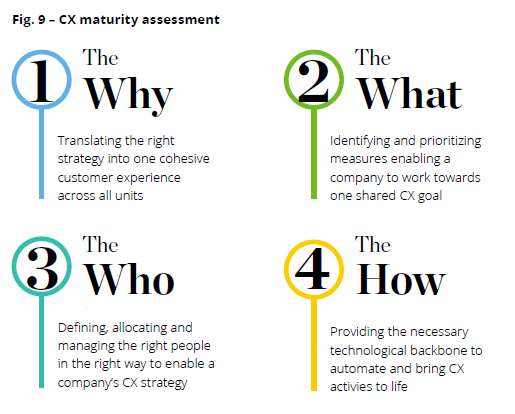Deloitte Digital Study: How to Build a Working CX Operating Model
Why a model
It happens that companies think they are already doing a good job but this 2019 study shows that there is often a large gap between the experience customers expect and what companies actually deliver.
Reasons for this gap might be:
Broken customer connectivity: Organizations built to fit internal processes may be counterproductive for customer-centric initiatives
Misaligned CX understanding: no thoroughly aligned CX strategy across all departments, lack of internal processes, principles, and responsibilities
Incomplete CX measurements: struggle to find the right metrics to link CX efforts to meaningful business results
Insufficient data insights: decisions are made based on gut feeling rather than on a solid evidence base
Lagging technological infrastructure: outdated IT architecture slows down or prevents companies from making data-driven decisions and acting quickly
Online obsession: focusing on online touchpoints solemnly while neglecting that a holistic customer journey includes online and offline touchpoints prevent companies from establishing a seamless experience
CX hyperactivity: too many projects and programs at once might be the reason why companies overall fail to build outstanding experiences
To overcome these challenges, Deloitte developed a framework with 4 core dimensions to map decision-making processes for effective customer experience.
Deloitte`s best practices
Structures & Functions:
It is not the entire organization that needs to change, but the way the organization coordinates its CX efforts and collaboration across functions
People & Talent:
A strong people and talent strategy enables companies to build internal capabilities, work in diverse, agile teams and sustain a high retention rate through continuous development programs
Governance & Power:
An effective governance style relies on clear incentives and enablement supported by resources and budgets paired with a transparent measurement and reporting culture
Data & Systems:
Digital organizations need clear ownership for data management with the right user enablement and clear value-creation processes
All dimensions are interdependent. If one lacks maturity, it will negatively impact every other area and automatically block initiatives in other fields.
How to measure maturity
In order to assess the overall CX maturity of an organization, Deloitte developed a proven approach:
Summing it up
The Why:
Companies need to ensure that their CX strategy transforms the brand strategy into the right brand experience across every touchpoint. For further adjustments, companies can link actionable KPIs linked to strategic objectives and financial targets in a transparent way and then measure the impact of CX.
The What:
Identifying relevant touchpoints and ranking them according to the CX value they contribute will help prioritize and act on the right CX measures. Achieving transparency through data will enable companies to optimize activities for the customer on an ongoing basis. Companies also need to find a way to efficiently coordinate and align their portfolio of CX initiatives with the organization’s objectives to avoid silos and, despite different customer segments, ensure a consistent and frictionless experience across all journeys.
The Who:
Customer experience must be discussed at board level to develop the right CX operating model and define roles and responsibilities to promote efforts across organizational silos. Fostering cross-functional collaboration lays the foundation for a seamless CX.
The How:
A company’s tech and data stack is the basis for insight gathering and automation at scale. The selection of the right technologies and tools is essential to operationalizing and automating CX efforts.

